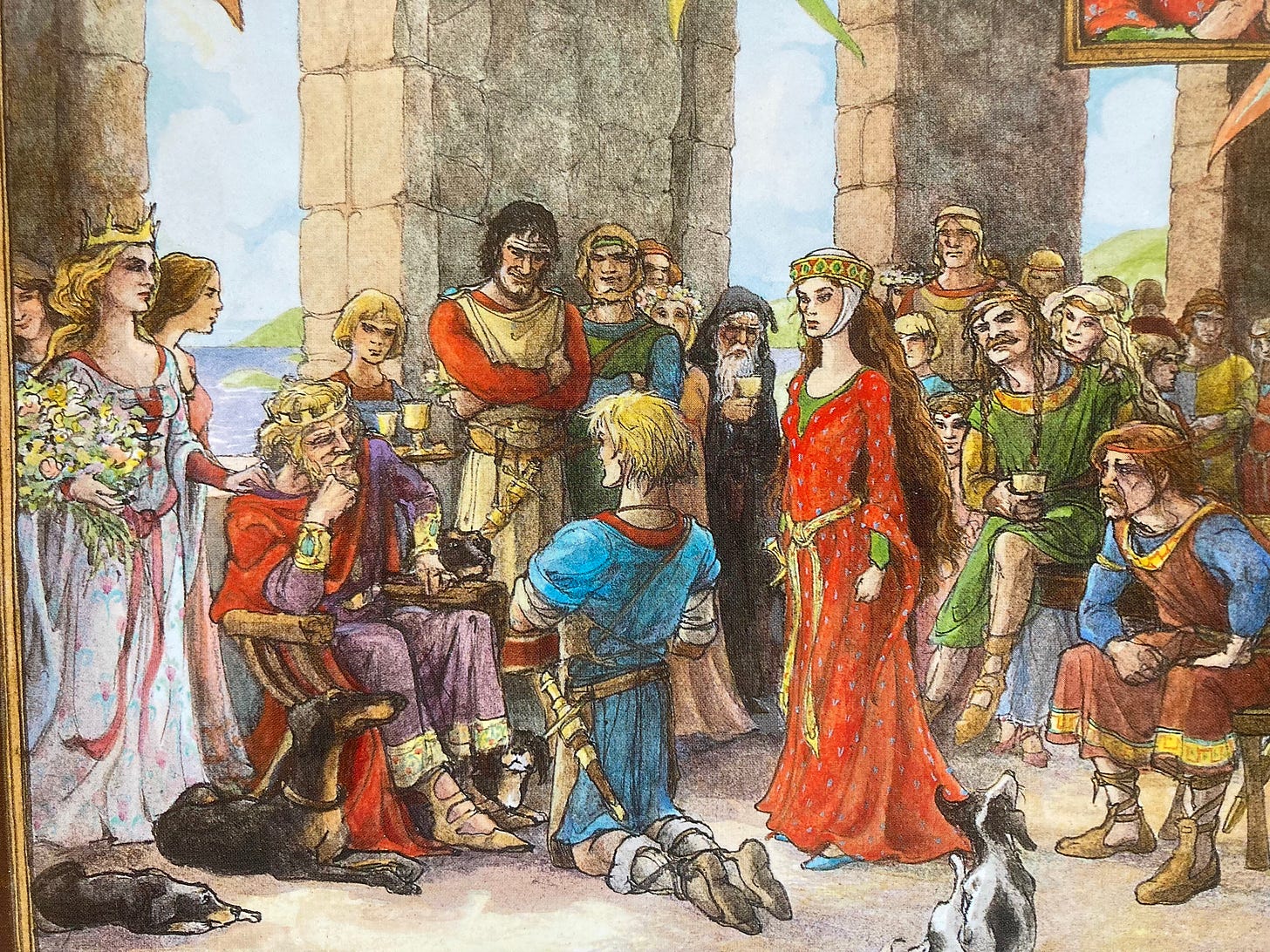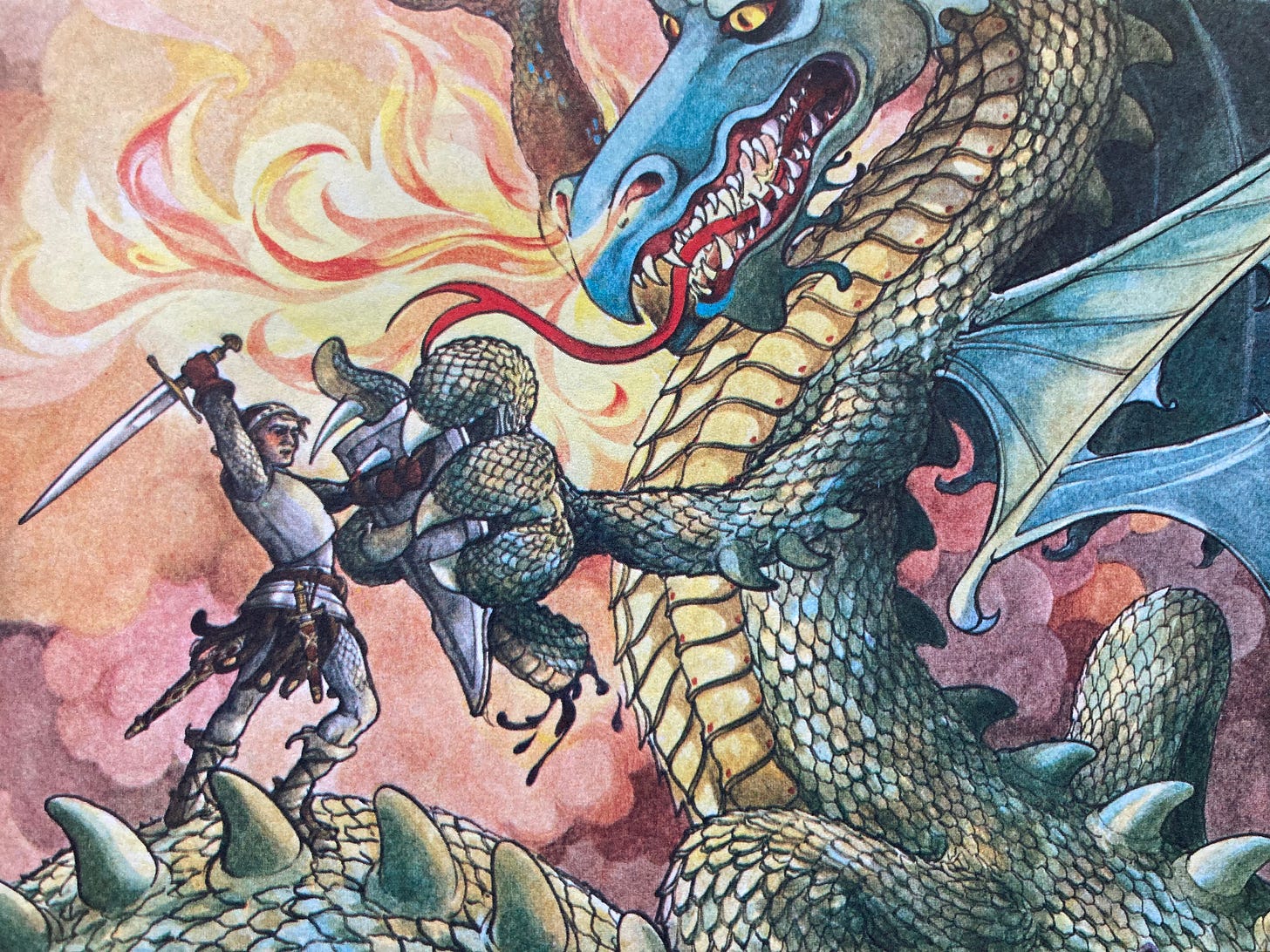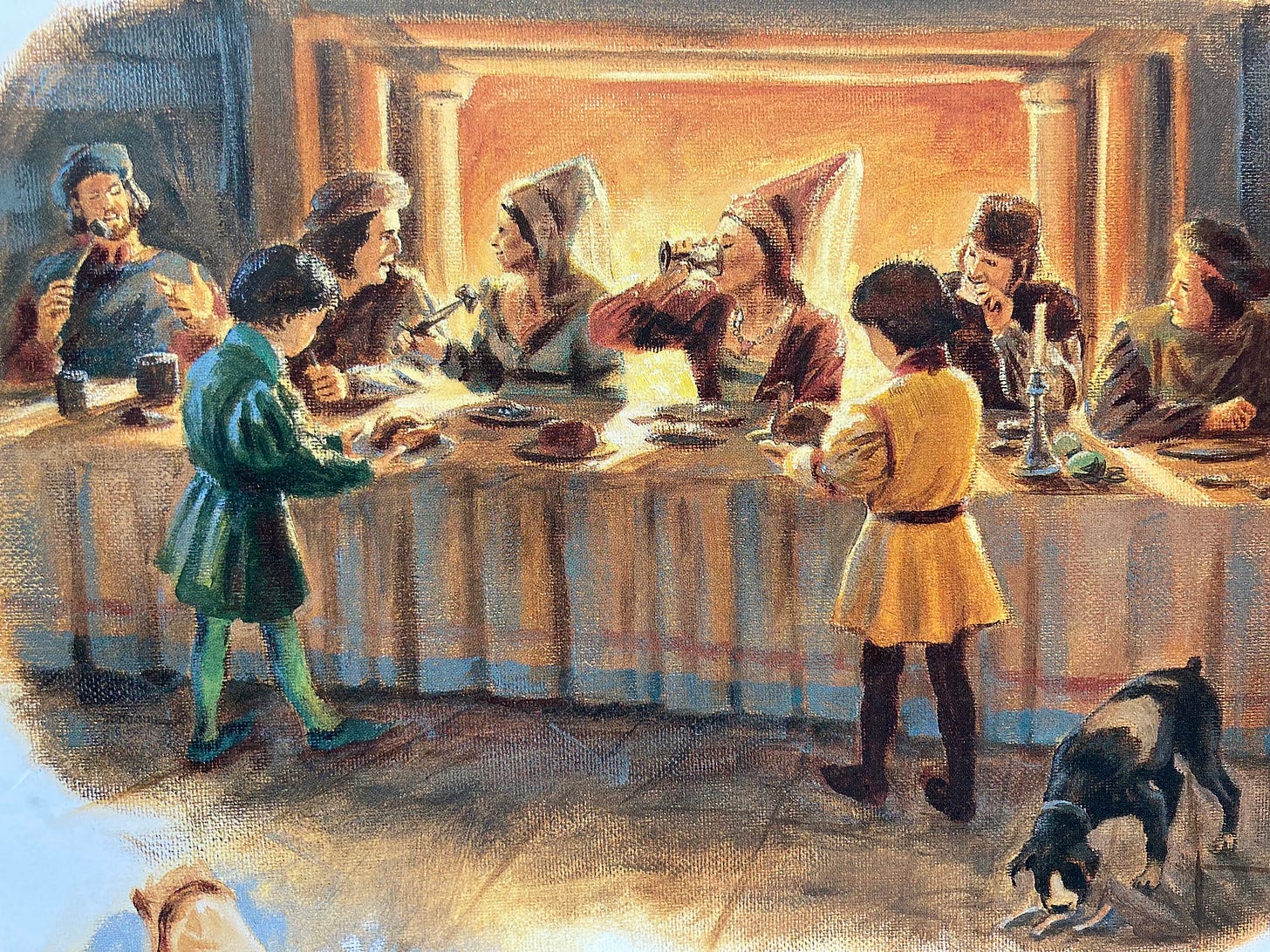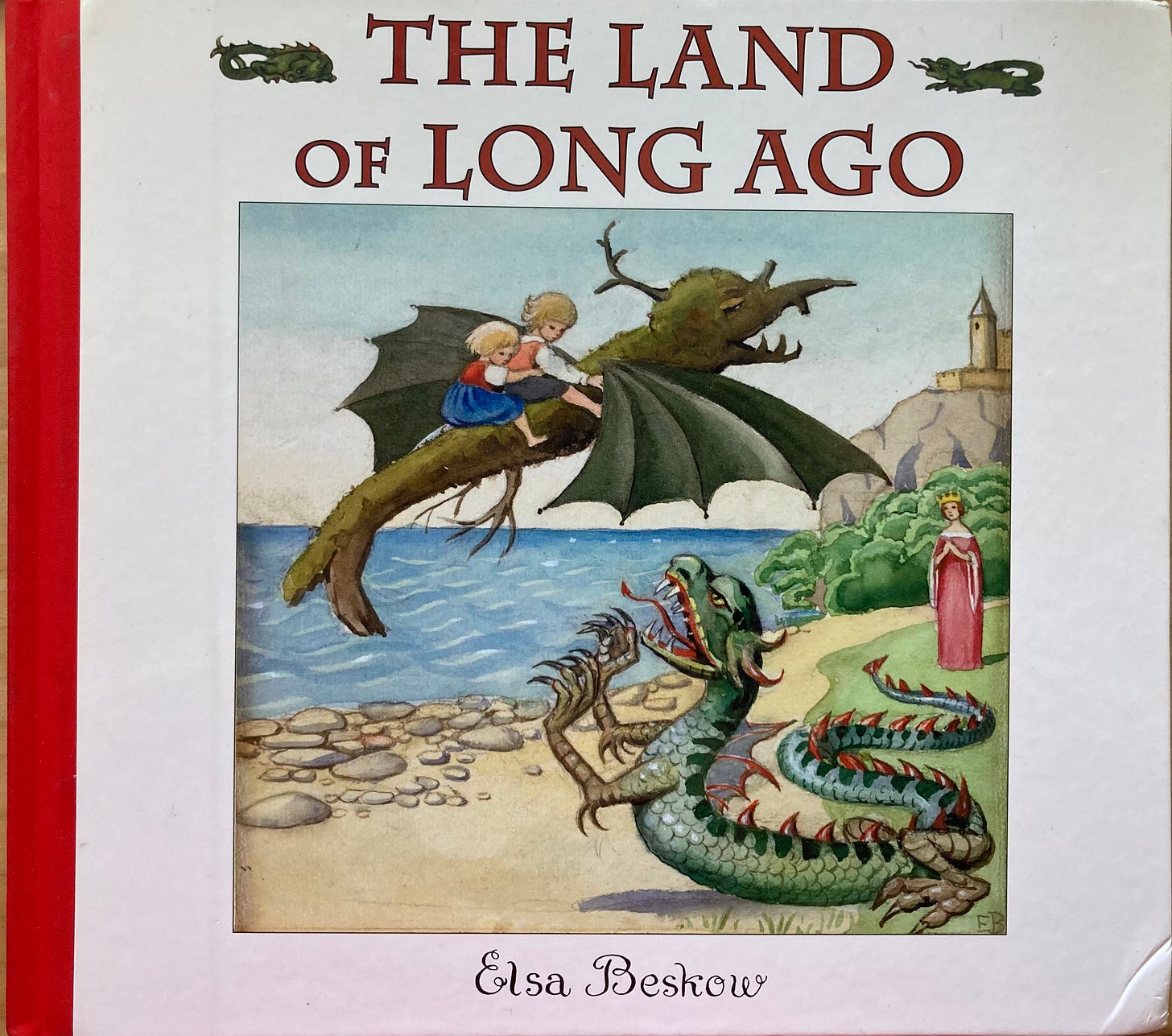The Enchanted Kingdom of Childhood
Knights' tales, learning reality through play, some good (and bad) books
I called the little pool a sea;
The little hills were big to me;
For I am very small.
I made a boat, I made a town,
I searched the caverns up and down,
And named them one and all.
And all about was mine, I said,
The little sparrows overhead,
The little minnows too.
This was the world and I was king;
For me the bees came by to sing,
For me the swallows flew.
From “My Kingdom” by Robert Louis Stevenson
In my last post, I wrote about how boys are builders, and it is good for them to have literary representations of that masculine quality. Another inborn tendency in boys is the desire to play out battles. Naturally, we read lots of knights and castle books in our home. And the boys love to set up Castle Game, as they call it. This is their way of living the storylines in the books that capture their imaginations. This is no mere playacting, either. It is the children practicing the virtues they admire in the protagonists of their stories.
One reader made a comment on a post here that, so often modern children’s stories do not contain plots. That is absolutely true and is part of why modern children’s literature is often uninteresting to children and also unedifying. For Aristotle, the plot constitutes “the soul of a tragedy” and character comes second. The plot drives action, which is significant for our purposes of understanding the relationship between literature and play in children.
I often contrast these modern plot-less stories with literature of old that is, as Stevenson’s poem above demonstrates, highly concrete and written with a view to the child’s imagination and its need for concreteness and rich description.
Where Margaret Hodges’s Saint George and the Dragon (affiliate link), for example, illustrates courage through the particular decisions and actions of the protagonist, Jessica Hische in Tomorrow I’ll be Brave (sorry, no affiliate link) gives the young reader a sentimental litany of abstractions about “being ____” (brave, creative, confident, and other distinctly modern virtues). You can read my review of Hische’s book in my list of the worst books for your child’s imagination.
These “children’s books for adults,” as I call them, resonate with the modern parent for their lofty sentimentalism, tickling the imagination of the parent rather than the child.
Books for kids should, first of all, contain a plot, and secondly, not dwell in the realm of abstractions. They should ignite the moral imagination through the actions of characters with admirable traits. They may contain a romantic storyline or romantic elements—that is, elements that are wild, unexpected, and unusual—that inspire wonder and enchantment. Yet these romantic elements, in a good story, operate within the God-given moral order. This order shall not be violated. That is, the romance of the story cannot trump moral reality no matter how fantastical or romantic the storyline (see the stories of George MacDonald or J. R. R. Tolkien for how to do this effectively).
Today, we turn to stories of knights and castles because boys take great delight in these adventures. These types of stories are particularly suited to sparking imaginative knightly and kingly play.
After many readings of many different knight and castle stories, my boys hustle to collect all of their sundry battle guys of various epochs and nations (green army guys, Indian figurines, plastic and wooden kings and queens and horses and knights, etc. etc.) and get to work laying foundations and drawing battle lines.

The play that this encourages is surprisingly elaborate. I have learned that in all of the different iterations of Castle Game, there is always one constant: an ironclad law of justice. There are multiple prison cells in their various castles and when I asked who goes there, the younger son responded, “the bad guys.” Who is a bad, I asked? The older son said, “traitors.”
These are not concepts I’ve ever explained theoretically, of course. They have picked up on these ideas from their stories.
What about the queen? I asked. Blank stares. From the younger one: she’s just upstairs. Oh? She doesn’t do anything? I asked. “There’s a war going on,” my older son responded, as if that was sufficient.

Castle Game is a complex setup involving the careful balance of interests between two (and, when they’re feeling generous, three) highly competitive boys. The older one has learned that, while he can easily dominate his younger brother, the fun will quickly come to an end. So he must find ways to compromise. The boys instinctively agree on the basic ordering principles: the bad guys must be imprisoned; thieves must be caught; there can only be one king; knights act honorably.
They’ve picked up on these ideas from the many, many books about King Arthur, Saint George, the sundry knights’ tales that they’ve read, and our history books.
Margaret Hodges has two wonderful books that we love: Saint George and the Dragon and The Kitchen Knight: A Tale of King Arthur (affiliate links). These books are beautifully illustrated by Trina Schart Hyman, and the details on every page make them each a treasure.
The Kitchen Knight tells the tale of a humble lad who, not wanting his noble lineage to do the work for him, asks King Arthur to allow him to work. The boy works in the kitchen for a year, and then asks to be permitted to go on a quest that had been requested of a knight from Arthur’s Round Table. A woman comes asking for someone to free her sister from captivity in the castle of the Red Knight. The lad, whose name is Gareth, is permitted to go on the quest.
The boys love the adventure story, which includes great battle scenes. I find the treatment of the knight at the hands of the sister who accompanies him to be one of the most edifying points of the story. This woman is startlingly rude to the young man, assuming him to be unworthy of the quest. After the boy defeats one knight, the woman says to him, “You smell of the kitchen and your clothes are foul with kitchen grease under your armor. Do you think I like you better for wounding that knight? You did not fight fairly. Go away, you lubber, you turner of spits and washer of ladles.”
“‘Madam,’ said Gareth, ‘say what you will, I shall fight against any knight who bars your way. I will follow this adventure to the end, or die in the attempt.’”
This is a good example for boys. In this Age of the Angry Feminist, boys would do well to prepare for encounters with women who do not behave like ladies. Preparing their imaginations for such an encounter will do them good. Gareth gives the reader an example of the perfect gentleman, even in the face of a most unpleasant woman.
It is helpful to show boys that such unladylike behavior is unworthy of gentlemen. This message comes through at the end of the story, when Gareth marries the ill-tempered woman’s sister. However, to her credit, the “proud woman” repents, asks forgiveness, and Gareth, of course, readily forgives.
Hodges’s retelling of the story of Saint George is another favorite. Hodge imagines all of the details of an extended, multi-day battle between St. George and the dragon, drawing it out just as the minds of young boys desire. Like Hodges’s other book, the beautiful details on every page, including borders, make this book a feast for the eyes.
Patrick O’Brien’s The Making of a Knight (affiliate link) is another great book. It tells the story of a a boy named James who wants to be a knight like his father. He must work for 7 years as a page and then 7 years as a squire before he can win his spurs. The details about how boys learned to ride, hunt, and sword-fight and medieval life in general are very interesting!
James must work very hard, from a young age, and he isn’t always doing knightly duties, either.
The Making of a Knight is a non-didactic book about knighthood, medieval life, the necessity of hard work and the satisfying rewards that follow.
One book about a knight that’s off-the-beaten path is Elsa Beskow’s The Land of Long Ago (affiliate link). In this whimsical story, a young brother and sister travel to a land of trolls, knights, and castles on the back of an enchanted log that turns into a flying dragon. Eventually, their homesickness draws them back to their parents in their little corner of the woods.
Finally, I’ll conclude with a recommendation for the Usborne Graphic Legends book, The Adventures of King Arthur (affiliate link) by Russell Punter and Andrea Da Rold. One of our sons has loved this book nearly to its death. Pages must be sorted and inserted in their proper places before each read. I won’t say who, but a certain six year-old has memorized many of the battle scenes, and I get to hear these recitations off and on throughout my day. I especially love when he says, “yield or die!” It’s just charming.
This one is in the comic book style, or “graphic novel” as the kids say. It made me uncomfortable, at first, having grown up a girl. It was, to be honest, my first encounter with a comic book up close. But apparently boys love these things, so I’ve made my peace with this non-traditional book that tells a very traditional tale.
When the boys play out the scenes from these stories, they are not simply recreating what they have read, although that is no doubt a part of their play. They are coming to terms with reality through play. They are experimenting and preparing for a life of action. Pretending to be fierce, courageous, and noble readies them to practice these virtues in real life.
How does this happen and why? We’ll explore the deeper epistemological significance of children’s “play acting,” and also why toys aren’t even necessary, in the next post.










I love Elsa Beskow. A Swedish treasure. Her illustrations are magical! Greetings from Stockholm!
I love bunk beds because somehow they afforded my kids, especially the boys, opportunities for re-enacting the books they loved! They can be castles and ships and all sorts of things, especially when you hang blankets off them etc.
For a while we had two sets of bunks in a room, and they were of different heights, so pushed together they made a sort of multi-level set of "rooms" for endless play.
Yes, who needs toys!! (That room was such a mess though, haha)
Great post!